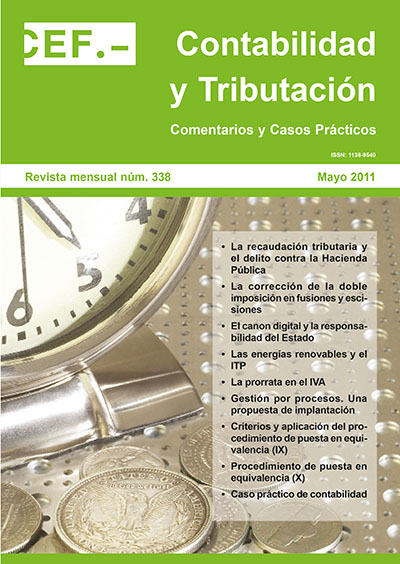Criterios y aplicación del procedimiento de puesta en equivalencia (IX)
DOI:
https://doi.org/10.51302/rcyt.2011.6797Palabras clave:
método de consolidación, procedimiento de puesta en equivalencia, método de la participación, influencia significativa, gestión conjunta, homogeneización previa, diferencia negativa de sociedades puestas en equivalencia, adquisición por etapasResumen
El método de participación puesta en equivalencia es el aplicado para proceder a la valoración de las sociedades multigrupo que no apliquen voluntariamente el método de integración proporcional y a las sociedades asociadas.
Se desarrolla cuando una sociedad puede entenderse que está influenciada significativamente y, por tanto, se trataría de una sociedad asociada.
El método de participación puesta en equivalencia se puede estructurar en tres fases:
1. Homogeneización o ajustes sobre los estados financieros individuales. No se rectifican los estados individuales, sino los estados aportados al consolidado para efectuar la valoración inicial y posterior.
2. Cambio de denominación. Este método se fundamenta en cambiar la denominación de las inversiones de sociedades asociadas o multigrupo, que pasan a llamarse participaciones puestas en equivalencia.
3. Valoración de la inversión. En un principio, se valora en el momento inicial por el valor razonable de los activos y pasivos que representa su participación con las limitaciones establecidas en la normativa para las combinaciones de negocio. Y posteriormente, cada vez que sucesivamente se realizan las cuentas consolidadas (cada año), se incrementa el valor de la participación por el incremento del patrimonio neto o se decrementa el valor de la participación por la disminución del valor del patrimonio neto de la sociedad participada.
Dentro de este proceso, es imprescindible la existencia de grupo para que se pueda aplicar el método de participaciones puestas en equivalencia, ya que, de no ser así, no habría sociedades multigrupo ni asociadas.
















